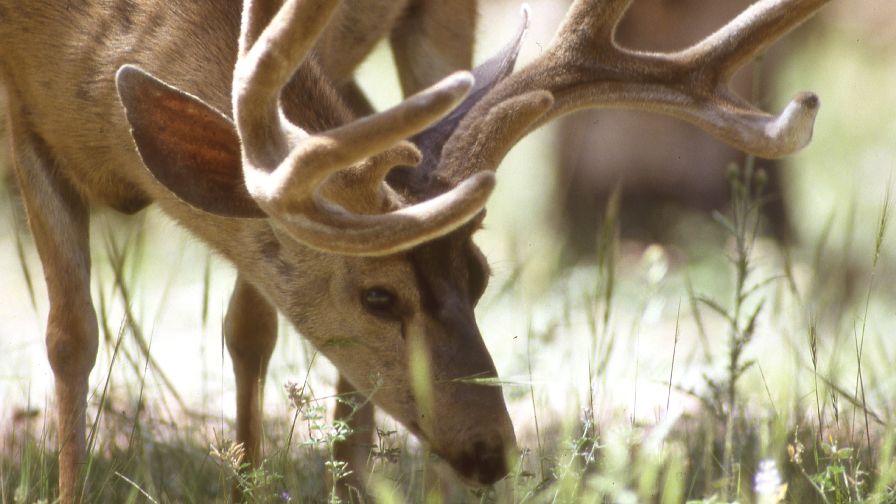How to Keep Wildlife Contamination of Field Crops to a Minimum

If you take 100 deer and sample them for E. coli, maybe one or two will show positive, while if you take the same number of cattle, 10 or 20 might be E. coli carriers,” says Anne Justice-Allen, Arizona Game & Fish Department Wildlife Veterinarian.
Photo by George Andrejko, Arizona Game & Fish
Where there’s crops, there’s critters. It’s just one of the many banes of produce growers facing new demands to both protect food safety and preserve environmental quality.
Whether it flies, scuttles, hops, or walks into a farm field on four legs, it’s generally hungry — on the prowl for new nutritional input and usually leaving excrement from its latest meal behind. How do farmers protect their crops from wildlife contamination?
In discussing food safety issues and their connection to wildlife, University of Georgia researchers Marilyn Erickson and Michael Doyle put it this way:
“Fruits and vegetables have become leading vehicles of food-borne illnesses, with most pathogens identified as the causative agents being enteric zoonotic pathogens typically associated with animal hosts.”
Depending on where you live and plant your crops, that list is long. It ranges from domestic animal feces (cattle, swine, sheep, goats, poultry) to those that wander in from the wild. That covers a lot of territory, from deer and bear to bobcats and coyotes. They’re all willing to defecate a token of their thanks for the opportunity to consume fresh crops.
“Zoonotic pathogens not only proliferate within domesticated animals but may also be resident within wildlife as a pathogen reservoir [with] the ability to easily intrude on farms,” Erickson noted in the introduction to the book, Food Safety Risks from Wildlife.
And with more than 250 pathogens and toxins that can be transmitted by food, that’s a concern. A quarter of the human pathogens infect both domestic and wild animals.
In a survey of 600 Central California irrigated row-crop growers — in the heart of what is referred to as “The Salad Bowl of America” — researchers Melanie Beretti and Diane Stuart reported that growers were experiencing a conflict in demands between food safety and environmental protection.
“Growers were taking a proactive approach to improve environmental quality,” they wrote, “adopting conservation practices to reduce chemical use, improve water quality, and protect wildlife, [but] some field-level interpretations of food safety requirements conflicted with those management practices.”
In fact, 8% of growers reported crop losses due to deer intrusion or potential contact with small animal or frog habitat.
Which Threat Is Greater — Wildlife or Livestock?
In that Central Valley survey, pretty close to nine out of 10 respondents indicated they had adopted at least one measure to discourage or minimize wildlife from cropped areas. The methods varied from bare-ground buffers, fencing, and trapping, to poisoned bait stations.
“Animals vary by type and volume of contamination,” says Arizona Game & Fish Department Wildlife Veterinarian Anne Justice-Allen. “If you take 100 deer and sample them for E. coli, maybe one or two will show positive, while if you take the same number of cattle, 10 or 20 might be E. coli carriers.”
“Cattle, like many ruminants, are natural reservoirs of E. coli, but they’re not marching around in crop fields like deer do,” says Paula “The Poop Doctor” Rivadeneira, Food Safety and Wildlife Extension Specialist at the University of Arizona Agriculture Center in Yuma.
In an ideal world, livestock can be made to stay in their own home through fencing, or penning, or being housed in barns. It’s a bit more difficult to keep out the bandit population, the eat-poop-and-run animal crowd.
Yuma’s critter cavalcade includes deer, coyote, javelina, birds, rodents, lizards, and wild burros, in addition to domestic animals who use local produce fields as a shortcut from Point A to Point B.
“Male dogs can smell a female in heat up to 5 miles away and tend to take a direct route to get to them. And that often means directly through a planted field,” Rivadeneira says.
When considering deterrent actions, “I encourage growers to go back to nature in trying to manage wildlife incursions, because studies have shown that some practices will actually force animals into the field,” Rivadeneira says.
It’s her job to assist fresh produce growers in excluding wild and domestic animals from their fields to prevent fecal pathogen contamination of crops.
Deterrent Strategies
There’s a long list of visual, auditory, tactile, lethal, and reproductive deterrents growers can use, Rivadeneira says. A few examples are: noise cannons, pyrotechnics, scarecrows, mylar strips, mirrors, lasers, live gunfire, and even sounds of injured wildlife (meant to deter that species, but often ending up attracting predators).
“Of course, there’s fencing, which is not only expensive but has to be very specific for the types of animals you’re trying to deter. Deer fencing, rabbit fencing, and reptile fencing are drastically different, and if a farmer doesn’t invest in the right one, it won’t help,” she says.
Effective deterrents can be found even on limited budgets.
“Expensive drones and other technology don’t work any better than low-tech solutions in the long term,” Rivadeneira says.
What to Do if You Find Wildlife Contaminants
When deterrents haven’t worked, and you are playing field-contamination catchup — like when you’ve already found scat in the strawberries — wildlife and animal management researchers at Cornell University recommend containing the damage to minimize it.
Cornell recommends growers take the following steps:
- Flag the affected area(s).
- Create a buffer zone — a minimum of a 5-foot-radius — to identify affected produce within that zone that you can exclude from harvest.
- Remove the feces and any affected produce.
- Dispose of it.
- Clean and sanitize all equipment and tools used, including boots and soiled clothing.
Thinking Outside the Box to Control Wildlife
Rivadeneira is studying how effective falcons and owls are in deterring nuisance birds and rodent populations from agricultural fields.
“Even though birds don’t generally hang out in the middle of a field of broccoli or carrots because they prefer to hang on the edges where there’s grass and other attractive edibles, they’re a big problem because they fly overhead and leave aerial fecal calling cards. And where you have cattle or a livestock feeding operation adjacent to a farm field, that means grain, and birds love grain,” Justice-Allen says.”You need to find some ways to minimize that attraction.”
Bigger flocking birds like grackles, starlings, and pigeons are attracted to feedstock and/or feedlot manure piles, but their waterfowl counterparts are also guilty carriers because their traditional watery habitats may have been contaminated upstream from animal feed operation runoff.
“Waterfowl, like those implicated in a couple of E. coli and salmonella outbreaks in California, are particularly bad because they may be living on or eating in contaminated water,” Justice-Allen says. “Finding critical control points, like sites where water is used to wash off field vegetables, is one way to manage contamination and reduce the spread of any possible pathogens.”
Rivadeneira is also seeking funding to start a habitat enhancement project to restore agricultural corridors for all kinds of wildlife around the fields.
“These are the kinds of things that, if used properly and together, will decrease animal intrusion, decrease the use of pesticides, decrease lethal animal control methods, and ultimately improve both farmer yield and food safety,” Rivadeneira says.










